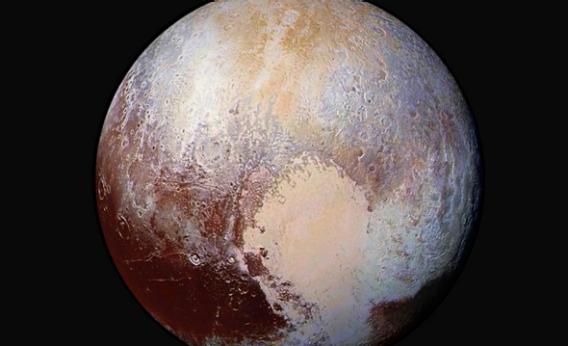Create a free profile to get unlimited access to exclusive videos, sweepstakes, and more!
A Slice of Pluto

As the New Horizons spacecraft continues screaming away from Earth at 14 kilometers per second—that’s 50,000 kilometers per hour—it sends back to us the data it took when it passed Pluto back in July. It’s a slow process, because at a distance of more than 5 billion kilometers the bitrate isn’t exactly great; it actually makes a dial-up modem look positively speedy.
Still, the data trickle down, and scientists back on Earth put the images together. We’re still getting some of the highest resolution images back now, and a new mosaic was just released that’s ridiculously cool. It shows a strip of Pluto stretching into the icy nitrogen plain of Sputnik Planum (the left side of the heart-shaped feature) that’s 80 kilometers wide and 700 kilometers long, with a resolution of about 80 meters per pixel!
And here it is: Take your time scrolling down it. You might need it.
W. O. W. Mind you, I had to shrink it to get it to fit the blog. Click it to see it full res, because, like I said, W. O. W.
Note: Scientists are still trying to figure out what’s going on in these images. Interpretation is very difficult; we’ve never seen Pluto up close before, and conditions there are literally unearthly. Some of the features have terrestrial analogues, which helps, but the very low temperatures, lower sunlight, thin atmosphere, and very different chemistry there make it really hard to know what’s what. I’ll speculate a little, but note that’s what it is: speculation. Hopefully we’ll understand this better soon.
So, the mosaic. At the top is the “coast,” where the tall water ice mountains meet the frozen nitrogen plain (at Pluto’s temperatures, water is hard as rock and can form mountains thousands of meters in height; nitrogen is solid but can act like an extremely viscous fluid; it can’t form hills because they’d just slump back down and become flat over time). The nitrogen forms segmented plates, common on Earth where water freezes in lakes as well. The segments are rippled (from compression?) and appear pitted. That may be due to sublimation, the weak sunlight still strong enough to turn the ice very slowly into gas, opening up small pits and enlarging them.
There are a couple of features I want to quickly point out. Near the top, where two segments meet, you can see dark streaks fanning out from the border between them to the lower right. There appears to be a dark splotch at the bottom of the border between the segments. Is that the source? The streaks almost look windblown. That would be quite a trick on Pluto, where the air is 0.00001 as thick as Earth’s! Still, it’s there, and time is something Pluto has plenty of.
I’m wondering if the bottom segment has a lower elevation in the middle; there’s also a dark streak running horizontally across it, as if material has collected in a central valley. On the right you can also see what looks like a hill poking out of the plains. Is it a gigantic boulders lodged in the ice, or the top of a mountain not quite covered by the flood of nitrogen? Or something else entirely?
This second close-up is from lower down in the mosaic, and shows what look like two more hills. The segments seem to converge and move around them, making me think these are the tops of larger hills poking out of the ice, and not rocks embedded in the ice. But geez, I’m totally guessing here. I have no clue about that black spot on the upper right, but it appears to have a swooping, subtle curved streak coming from it. I can’t explain it, but I enjoy looking at it and scratching my head. Maybe you do too.
It’s funny. When I write a blog post, I like to explain what you’re seeing. I usually can, at least a little! But when it comes to Pluto, the best I can do is point at stuff and say, “What the heck?” Even the experts are baffled by a lot of this; I don’t think anyone who studied Pluto ante–New Horizons would have dreamed that the surface of this little world would be so incredibly diverse. Every press conference after the flyby was punctuated with the scientists saying how surprising Pluto is.
But it was also accentuated with the broad smiles on all their faces. Scientists love being in this situation. Love it! It’s an entirely new world to explore! And with new data coming down every week, we still haven’t seen all there is to see.
Eventually we’ll understand it, or at least understand it better. That’ll take a while. I love knowing what it is I’m seeing … but I also love a mystery. So either way, I’m pretty happy.
Post script: Over the holiday I posted an amazing video of Pluto taken with the LEISA camera on New Horizons; traffic is usually low at that time so you might have missed it. Trust me, this is very, very cool and worth your time to see!














